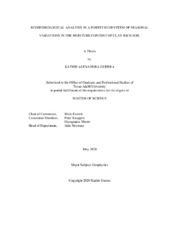| dc.description.abstract | Soil water availability influences the physiological, structural, and functional properties of plants. The physical properties of the soil play an important role in determining water availability, and shapes both the root distribution and tree adaptability to changes in weather and climate. Electrical resistivity tomography (ERT) is a nondestructive geophysical method that images spatiotemporal variations in bulk soil resistivity, which, in turn, can be related to variations in soil water content. The goal of acquiring ERT data is to help ecohydrologists to better understand how seasonal variations, climate change and land usage can affect hydrologic fluxes and the sustainability of an ecosystem. My study analyzes the soil moisture regime in Danciger, a forested site located in the San Bernard watershed floodplain in Brazoria County, Texas. Additional data from nearby Dance Bayou and Otto forested sites were also obtained. These soils are composed primarily of clay. Clays increase the overall bulk electrical conductivity of a soil due to their negative surface charges that create an efficient electrical conduction pathway. An important objective of my study is to understand how soil moisture content and water uptake from the trees affects the ERT response. The goal is to better understand the soil-water dynamics in relation to the water needs of the plants. To observe subsurface soil moisture variation caused by seasonal weather variations, several ERT surveys were collected throughout the year. The resulting time-lapse geophysical images provide spatiotemporal information about the ecohydrological processes of the trees that pertain to soil moisture variations within the root zone. The results suggest that tree water uptake depletes soil water content in the root zone during the growing season. Surficial soil moisture could be redistributed by the roots, decreasing the soil moisture in deeper zones. Deep soil moisture remains relatively unchanged throughout the year, possibly indicating that water infiltration is low in the clay-rich soil for most of the year. Some infiltration was inferred after the winter. The ERT results are compared to laboratory experiments that correlated resistivity to soil moisture in order to constrain the geophysically-determined estimates of the water content in the soil. | en |


